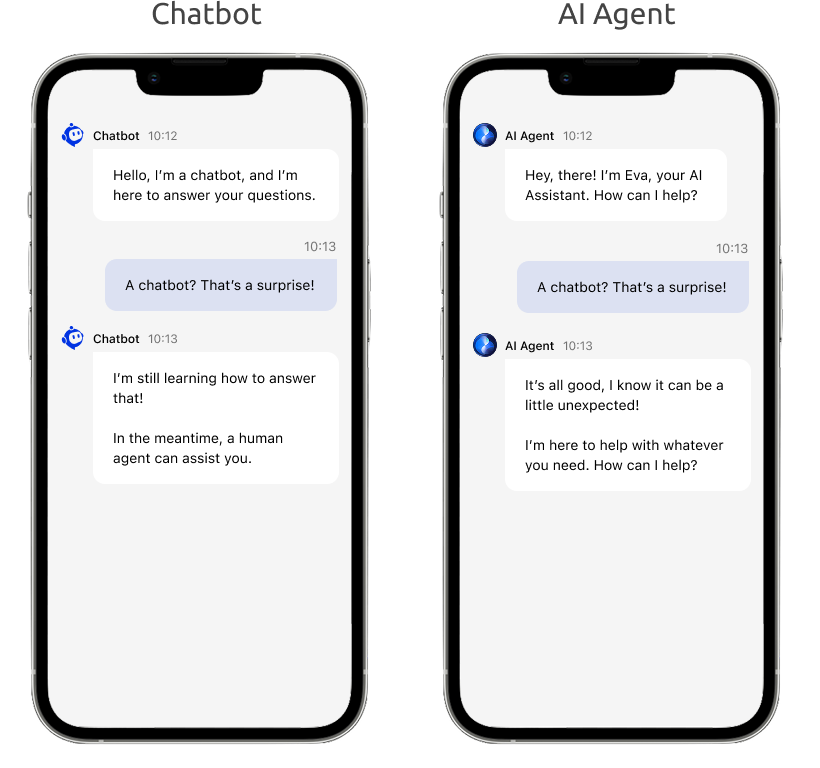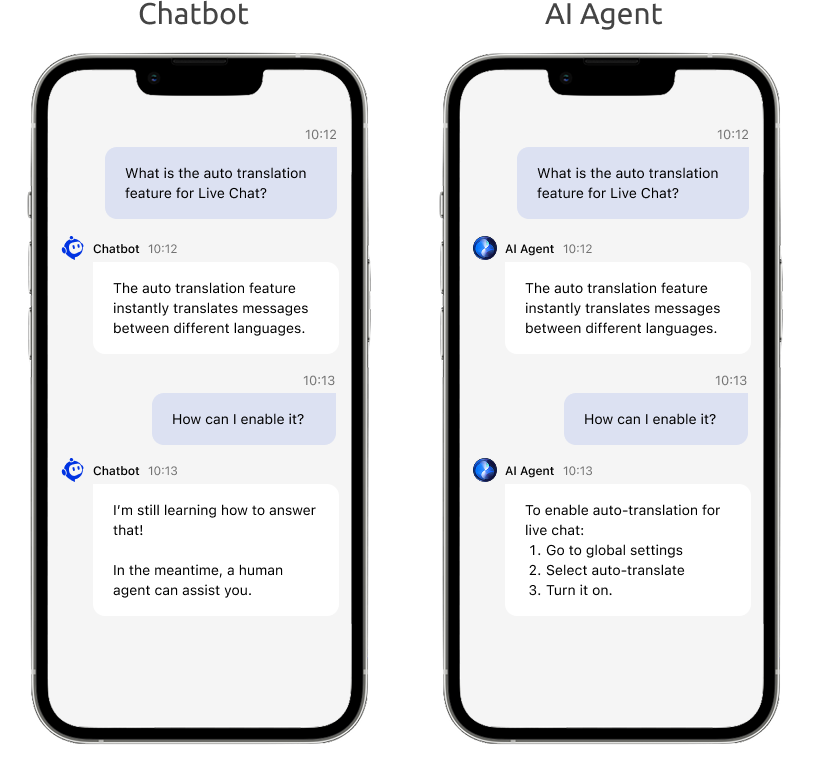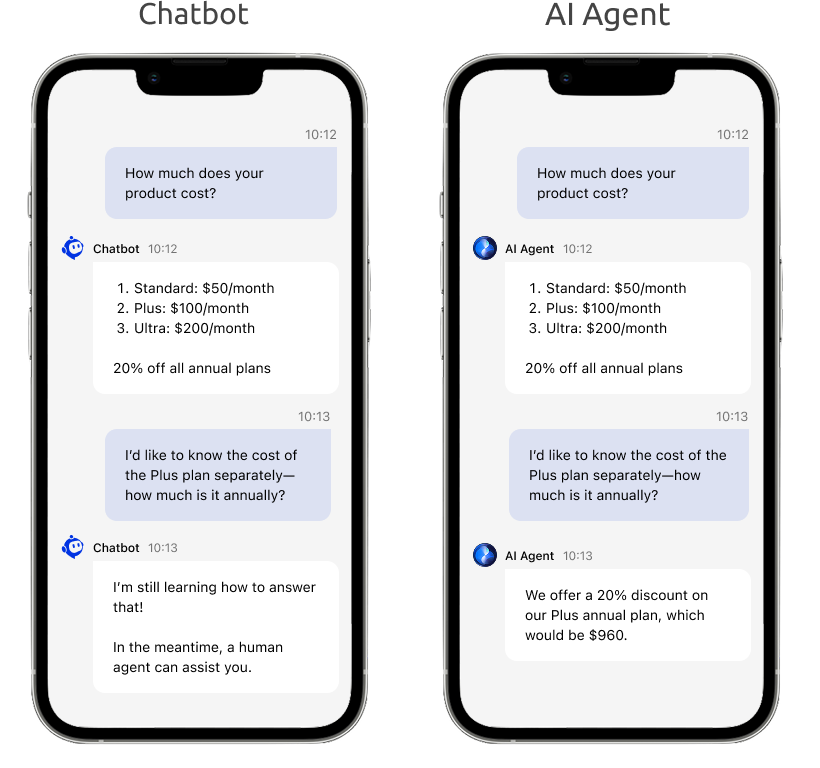I could start this article with a history of how technology has impacted sports betting. I could drone on about the incremental benefits + Read More
Live webinar: Cut costs, grow revenue - Discover the new Comm100 AI trifecta ✨
Register nowLive webinar: Cut costs, grow revenue - Discover the new Comm100 AI trifecta ✨
Register now
Remember those early days when most chatbots were just glorified FAQ machines? They’d spit out pre-programmed answers, stumble over anything remotely complex, and leave you typing stuff like “Agent” or “Are you joking? That’s all you can say?!” just to get a resolution.
Yeah, those days are over.
AI agents aren’t just here to chat; they can now think, reason, and act. They don’t just pull answers from a script; they analyze, predict, and adapt. Simply put:
Chatbots respond, AI agents reason.
AI agents are the next iteration of chatbots. Our research shows that chatbot adoption has jumped up sharply, by 17.66% in the past year alone, and with AI agents, we anticipate adoption to go into overdrive in the next 12-24 months.
So what are some of the main differences that set AI agents apart from a conventional chatbot? Let’s take a deeper look.
You may have visited sites where as soon as the page loads, a little window pops up asking, “How can I assist you today?” That’s likely a chatbot initiating a conversation.
Your questions may get answered, but only in a painfully robotic way. You ask something slightly complex, and suddenly, you’re in a loop of “I’m sorry, I didn’t understand that. Could you rephrase?”
Chatbots are rule-based programs designed to simulate human conversation—kind of like the old-school “choose your own adventure” books but for customer service. They operate on predefined scripts, keyword matching, and in some cases, basic AI functionality to recognize common questions and respond accordingly.
Most chatbots generally follow a fairly rigid decision tree. They operate on predefined scripts and follow specific rules set by developers, making them suitable for handling straightforward tasks like answering frequently asked questions.

Chatbots can struggle with unexpected queries outside their programmed scenarios. While they use basic natural language processing (NLP) to recognize user input, their understanding of language is far from the nuanced comprehension of large language models (LLMs) that you’ll find behind AI agents.
On practical terms, chatbots make it easy for organizations to automate and address a significant percentage of routine queries. Their structured nature makes them efficient at delivering quick, standardized responses, making them a cost-effective solution for businesses looking to manage high volumes of basic interactions.
However, their limitations become clear when conversations deviate from expected paths; they struggle with context, can’t adapt dynamically, and lack the ability to learn from previous interactions.
AI agents have the ability to reason and understand your request. Think of them as intelligent problem-solvers that go well beyond just answering questions. They are also more autonomous in nature, constantly learning and better understanding the flow of conversations.
AI agents combine multiple technologies to create a more sophisticated and adaptive system for providing responses. They go beyond basic natural language processing (NLP) and use:
Absolutely. Organizations that value the quality of customer service would be far better served deploying an AI agent than using just a chatbot. While chatbots offer many advantages, AI agents are much more intuitive across different channels and can also process more than text: they can process video, audio, and images.
And, as you’ll find in the following sections, the benefits that AI agents offer make them a superior choice by far.
| Feature | AI Agents | Chatbots |
|---|---|---|
| Understanding | Understands context, intent, and adapts dynamically. | Recognizes keywords and follows scripts. |
| Learning Ability | Learns from interactions and improves over time. | Static responses, needs manual updates. |
| Task Execution | Can complete complex workflows and take actions autonomously. | Answers questions, provides basic automation. |
| Personalization | Adapts responses based on history and user behavior. | Limited to predefined paths. |
| Handling Complexity | Can manage intricate tasks and decision-making processes. | Struggles with multi-step or nuanced conversations. |
Chatbots essentially scan user input for familiar words and generate responses based on a predefined flow. If a chatbot isn’t programmed to recognize a phrase, it either returns an irrelevant response or asks the user to rephrase.

AI agents are more nuanced, and can analyze context, sentiment, and intent, enabling them to grasp complex inquiries even when phrased in unexpected ways. This results in more human-like interactions and a significant reduction in frustrating “I don’t understand” responses.
AI agents are capable of handling small talk and can even juggle multiple topics.
One of the most powerful capabilities of AI Agents is dynamic retrieval, which allows them to pull relevant information from multiple sources in real time.
Unlike chatbots that rely on preloaded responses, AI Agents can search, retrieve, and synthesize data on demand, ensuring users receive the most accurate and up-to-date information. This is true even for custom bots, like higher education chatbots, for instance.

In the screenshot above, you can see the chatbot fails to answer follow-up questions about a specific pricing option. The Comm100 AI Agent, on the other hand, can discern the intent, and even layers a discount option when responding.
AI agents leverage real-time data integration and retrieval techniques to access and process information from various databases, APIs, and knowledge repositories.
This means they don’t rely on a fixed set of responses but instead fetch the latest and most relevant data based on user input.
The Comm100 AI Agent can search for answers from a multitude of sources:
This offers a slew of benefits to customer support teams who can answer more, and more complex queries by accessing more data sources in different formats. In most cases, once the AI agent is deeply integrated into a company’s business systems, it can perform a wide variety of tasks. For instance:
Let’s be honest, chatbots are great for answering basic questions, but when things get complicated, they quickly hit a wall. They can tell you your order status, but can they fix a problem, process a refund, and update your account at the same time? Not really.
AI agents do more than chat; they get things done (you know, like a human agent). They don’t just provide information; they act, handle multi-step workflows, and even make smart decisions based on real-time data.
Whether it’s troubleshooting an issue, approving a request, or streamlining business operations, AI Agents can execute tasks end to end without human intervention.

As you can see from the screenshot above, the real beauty of AI Agents is that they don’t just follow rigid rules like chatbots. They analyze the situation, pull in relevant data, and figure out the best way to solve the problem.
That means less manual work, fewer mistakes, and faster resolutions, whether for customers, employees, or business operations.
Here are just a few examples of how AI agents can help resolve more complex tasks in different industries:
Every interaction with an AI agent serves as a learning opportunity. Unlike traditional chatbots, which are stuck with whatever they were programmed to know and do, AI agents get smarter with every interaction.
This happens due to a combination of machine learning (ML) techniques, adaptive AI models, and real-time feedback loops. At the core of this learning process are three key mechanisms:
Each of these plays a critical role in allowing the AI agent to understand queries, detect intent, and provide a viable answer.
Supervised Learning
Supervised learning allows AI agents to improve response accuracy by training on labeled datasets (such as conversation histories), where historical user interactions are mapped to the correct intent and expected outcomes.
This is particularly useful for intent recognition models, where the agent refines its ability to classify user input correctly over time. With transfer learning, pre-trained models can be fine-tuned on domain-specific data, enabling AI agents to specialize in different industries or user contexts with minimal retraining.
Unsupervised Learning
Then, there’s also unsupervised learning that helps AI agents identify hidden patterns and relationships in user interactions without explicit labels. Techniques like clustering and topic modeling allow the AI to group similar user queries, enabling more nuanced and adaptive responses.
For example, an AI Agent handling customer support may start recognizing emerging issues by clustering related complaints before they are explicitly reported, allowing for proactive problem resolution.
Reinforcement Learning
A critical part of training is reinforcement learning (RL). Reinforcement learning (RL) helps AI Agents get better at making decisions and handling complex tasks over time. Instead of following fixed rules, they learn through trial and error, just like humans do when practicing a skill.
Every action they take is evaluated based on success metrics, such as how quickly an issue is resolved, how satisfied the user is, or whether the task was completed correctly. As the AI interacts more, it figures out what works best and fine-tunes its approach.
By analyzing user interactions, error corrections, and explicit feedback (such as thumbs-up/down ratings), the agent fine-tunes its natural language understanding (NLU) models to minimize misunderstandings and improve contextual accuracy.
Additionally, integration with external knowledge bases, APIs, and live data streams ensures that responses remain up to date and aligned with evolving user needs.
Chatbots had their moment. They helped automate simple interactions, provided quick answers, and saved businesses time, but they have clear limitations. They struggle with complex conversations, can’t adapt on their own, and often frustrate users when a request falls outside their scripted responses.
AI Agents, on the other hand, are a leap forward in intelligent customer service automation. This shift from basic automation to adaptive intelligence is what sets AI Agents apart. They offer faster, more personalized experiences, seamlessly integrate with business systems, and ultimately drive real outcomes; whether it’s solving customer issues, streamlining operations, or improving decision-making.
Ready to explore how AI agents can revolutionize your customer service? Request a demo today!